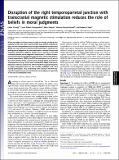Disruption of the right temporoparietal junction with transcranial stimulation reduces the role of beliefs in moral judgments
Author(s)
Young, Liane; Camprodon, Joan Albert; Hauser, Marc; Pascual-Leone, Alvaro; Saxe, Rebecca R.
DownloadYoung-2010-Disruption of the ri.pdf (271.2Kb)
PUBLISHER_POLICY
Publisher Policy
Article is made available in accordance with the publisher's policy and may be subject to US copyright law. Please refer to the publisher's site for terms of use.
Terms of use
Metadata
Show full item recordAbstract
When we judge an action as morally right or wrong, we rely on our capacity to infer the actor's mental states (e.g., beliefs, intentions). Here, we test the hypothesis that the right temporoparietal junction (RTPJ), an area involved in mental state reasoning, is necessary for making moral judgments. In two experiments, we used transcranial magnetic stimulation (TMS) to disrupt neural activity in the RTPJ transiently before moral judgment (experiment 1, offline stimulation) and during moral judgment (experiment 2, online stimulation). In both experiments, TMS to the RTPJ led participants to rely less on the actor's mental states. A particularly striking effect occurred for attempted harms (e.g., actors who intended but failed to do harm): Relative to TMS to a control site, TMS to the RTPJ caused participants to judge attempted harms as less morally forbidden and more morally permissible. Thus, interfering with activity in the RTPJ disrupts the capacity to use mental states in moral judgment, especially in the case of attempted harms.
Date issued
2010-04Department
Massachusetts Institute of Technology. Department of Brain and Cognitive SciencesJournal
Proceedings of the National Academy of Sciences of the United States of America
Publisher
National Academy of Sciences (U.S.)
Citation
Young, Liane et al. “Disruption of the right temporoparietal junction with transcranial magnetic stimulation reduces the role of beliefs in moral judgments.” Proceedings of the National Academy of Sciences 107.15 (2010): 6753 -6758. Copyright ©2010 by the National Academy of Sciences
Version: Final published version
ISSN
0027-8424
1091-6490